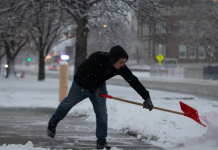Cool- and warm-season grasses need year-round care
By Emily Halstead, K-State Research and Extension news writer
MANHATTAN, Kan. — Keeping a healthy home lawn can be difficult for those who are not well versed in horticulture and lawn care. Kansas State University horticulture specialist Ward Upham shared his tips for maintaining a healthy lawn in Kansas.
“We live in a transition zone where we are too warm to grow cool-season grasses well, while also being too cold to grow warm season grasses well,” Upham said.
Some examples are fescue and Kentucky bluegrass which are cool-season grasses; and bermudagrass, zoysia and buffalo grass, which are warm-season grasses.
While buffalograss may not always grow well in Kansas, it is one of the most popular turfgrass species in the state, along with tall fescue Upham said.
“Buffalograss has become more popular in recent years due to its reputation as a low maintenance grass,” Upham said.
Upham gave some tips and things to look out for in home lawns in fall, winter, spring and next summer.
Fall
• Get ready to fertilize in September and early November for cool-season grasses.
• If broadleaf weeds are an issue, spray for them in late October. Treat on a day that is at least 50 degrees Fahrenheit and do not irrigate within 24 hours.
Winter
• Winter is the time for dormant overseeding, if there is a need to fill in bare spots that were not overseeded in the fall.
• Dormant overseeding can be effective for cool-season grasses when done in small areas of a lawn from December through February.
Spring
• Crabgrass preventer can be applied between April 1 and April 15. If using a product that contains prodiamine, the preventer should be applied two weeks earlier.
• For crabgrass preventers to work, they must be watered in, meaning the product must be washed into the soil either by rain or watering.
• If broadleaf weeds are still an issue in the spring, spot treatment can be helpful.
Summer
• June is a good time to aerate warm-season lawns.
• Late July through August is the best time to apply a grub killer if experiencing grub damage.
“Summertime is very difficult for cool-season grasses because they do not have the heat or moisture stress tolerance that warm season grasses have,” Upham said.
He added that lawn care in Kansas can be tricky, but K-State Research and Extension has many helpful publications, and experts to answer questions.
-30-
FOR PRINT PUBLICATIONS: Links used in this story
K-State Research and Extension publications (lawn and turf), https://hnr.k-state.edu/extension/publications/lawns-and-turf.html
K-State Research and Extension is a short name for the Kansas State University Agricultural Experiment Station and Cooperative Extension Service, a program designed to generate and distribute useful knowledge for the wellbeing of Kansans. Supported by county, state, federal and private funds, the program has county extension offices, experiment fields, area extension offices and regional research centers statewide. Its headquarters is on the K-State campus in Manhattan. For more information, visit www.ksre.ksu.edu. K-State Research and Extension is an equal opportunity provider and employer.
Story by:
Emily Halstead
[email protected]
For more information:
Ward Upham
785-532-6173
[email protected]





